Few things are more frustrating than finding a leak around your chimney after a heavy rain. Sometimes it’s a slow drip; other times water runs down your wall or stains your ceiling. Either way, it’s a problem that won’t go away on its own. A chimney that’s leaking can lead to mold, wood rot, and costly repairs if ignored.
At RoofPRO, we’ve repaired every type of chimney leak imaginable across Maryland homes—from brick chimneys with crumbling mortar to vinyl and wood-sided chimneys with failed flashing or missing caps.
Signs You Might Have a Chimney Leak
For Maryland property owners, leaking chimneys are especially problematic due to the region’s climate, which brings plenty of rain, snow, and temperature fluctuations. Chimney leakage often starts small, but it can quickly escalate into major problems if left unchecked. Here are some common signs to watch out for:
Dripping Sounds in the Fireplace
Have you ever heard a dripping sound coming from your fireplace? This is a telltale sign of a leaking chimney. Rainwater can enter through cracks in the chimney and collect in the firebox, creating that unmistakable dripping noise. If you hear this, it’s time to investigate further.
Water Stains on Ceiling or Wall
One of the most obvious signs of a chimney leaking is stains on your ceilings or walls. These stains often appear as brown or yellowish spots and may be accompanied by peeling paint or wallpaper. If you notice these stains near your fireplace or chimney, it’s a clear indication that moisture is getting in somewhere.
Musty Odors or Mold Growth
Moisture leads to musty odors or even mold growth in your home. Mold thrives in damp environments, and a leaky roof provides the perfect conditions for it to grow. Not only is mold unsightly, but it can also pose serious health risks, especially for those with allergies or respiratory issues.
Common Types of Chimney Materials
Before diagnosing a leak, it’s important to understand what type of chimney you have, since each one has its own weak points. Even a well-built chimney can develop issues over time, but if it wasn’t constructed properly from the start—or if outdated methods were used—problems are much more likely to appear.
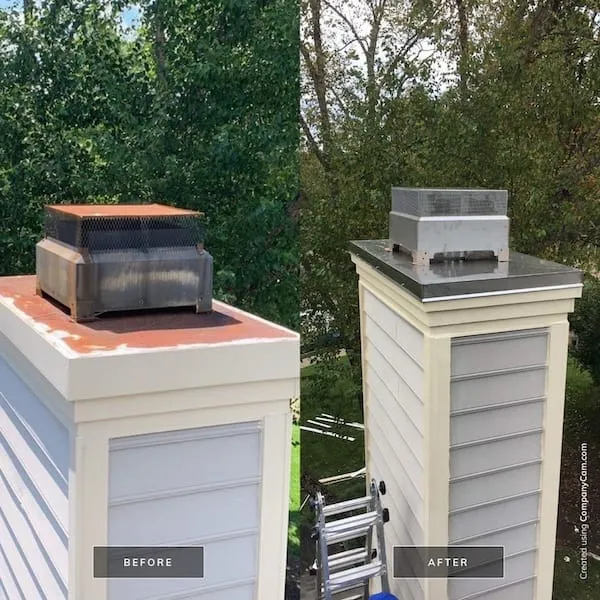
Vinyl
These are framed and wrapped with siding material. Leaking usually occurs from failed house wrap, step flashing, or caulking around trim boards and caps. Once water gets behind it, it runs down the wall and soaks into framing or drywall inside.
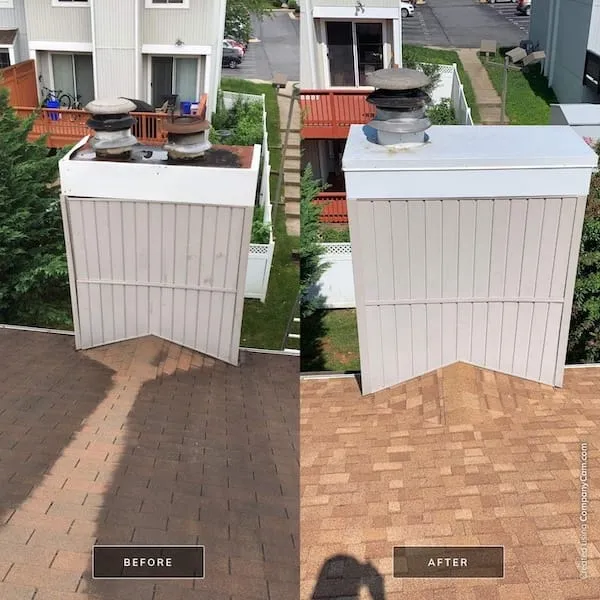
Wood Siding Chimneys
Beautiful, but prone to water intrusion through deteriorated caulk, gaps in trim, or missing house wrap. Moisture can travel down the wall unseen before appearing indoors. Wood siding needs consistent maintenance. When caulk cracks or trim boards pull away, rainwater seeps in and damages the sheathing beneath. Missing or torn house wrap makes the issue worse, letting moisture travel freely behind.
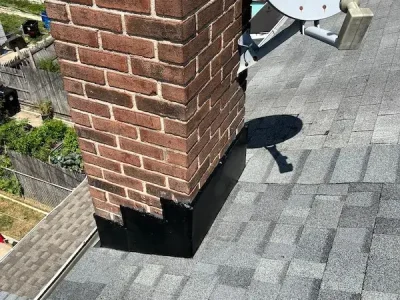
Brick Chimneys
Classic and durable, but porous. Rainwater can seep through cracks in the mortar or crown or around ruined flashing where the chimney meets the roof. Brick chimneys often leak due to deteriorated mortar, cracked crowns, or missing counter-flashing. When the mortar crumbles, it allows moisture to soak through, especially in freezing conditions where moisture expands and worsens the cracks.
What Causes Chimney Leaks?
A leaky chimney isn’t always straightforward. In many cases, the problem isn’t the chimney itself but the surrounding roof or flashing. Knowing what typically causes these leaks can help you spot issues early and prevent a small problem from turning into a costly repair.

1. Cracked or Missing Chimney Crown
The chimney crown is the concrete or mortar layer at the top of your chimney. Its job is to direct water away from the flue and prevent it from entering the chimney. However, exposure to the elements can cause the crown to crack, creating an entry point for moisture. Even small cracks can evolve into big problems if not addressed promptly.
2. Damaged or Improper Flashing
Chimney flashing is the metal strip that seals the gap between your chimney and roof. It’s designed to keep water out, but over time, it can become damaged or corroded. Improperly sealed joints or insufficient flashing lead to weak points where water begins its journey into your home.
3. Missing or Damaged Chimney Cap
Chimney caps cover the top of the flue and prevent water, debris, and animals from entering. When it’s missing or impaired, rain can pour straight down into the chimney, leading to moisture buildup, interior stains, and structural damage. Even though a cap is a small component, it plays a major role in keeping your chimney system dry and protected.
4. Moisture Through Bricks or Mortar
Mortar is the material that holds the bricks of your chimney together. Over time, exposure to rain, snow, and temperature fluctuations can cause the mortar to degrade. This process, known as spalling, weakens the chimney’s structure and allows water to penetrate. If you notice crumbling or missing mortar, it’s a sign that your chimney needs attention.
5. J-Channel or Trim Leaks on Sided Chimneys
On chimneys finished with vinyl or wood siding, water often sneaks in around the trim or J-channel. These components are meant to direct water away from the siding and toward the exterior of the wall, but if they’re installed incorrectly or become clogged with debris, they can do the opposite—channeling water behind the siding instead. Once moisture gets trapped behind the siding, it can soak the house wrap, rot the sheathing, and eventually show up as interior leaks around the chimney.
6. Missing Cricket
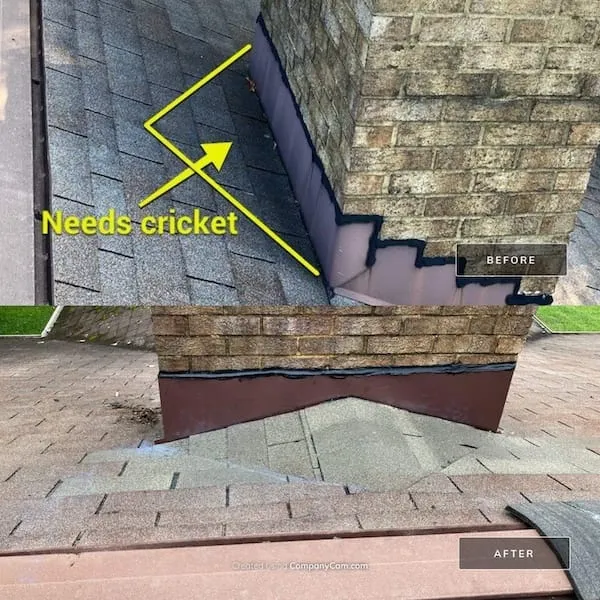
If your chimney is wider than 30 inches and doesn’t have a cricket—a small, peaked ridge built into the roof behind the chimney—water can collect where the two surfaces meet. During heavy rain, this area becomes a catch basin where water pools and slowly works its way under the flashing or shingles. Over time, that standing water leads to leaks. A properly built cricket redirects rainwater around the chimney instead of letting it sit, protecting both the roof and the chimney’s structure from long-term moisture damage.
How to Fix a Leaking Chimney
Chimney repair starts with identifying where the water is getting in. Once the source is found, here’s how each problem is corrected:
Cracked Crown Repair
Remove loose or crumbling material and repour or seal the crown using waterproof masonry products. For severe damage, a full rebuild may be needed.
Fixing Flashing Issues
Remove old materials around the chimney. Install new step flashing, counter-flashing, and underlayment to create a watertight seal before reinstalling shingles.
Vinyl or Wood Siding on the Chimney
Remove ruined material around the leak area. Install new house wrap, tape all seams, and replace flashing around windows or roof intersections. Reinstall new siding and seal all joints with exterior-grade caulk.
Building a Cricket
For larger chimneys, it’s important to install a properly built metal or shingled cricket to divert water around the backside of the structure. This involves framing a small ridge behind the chimney using 2x4s and plywood, creating a gentle slope that directs rainwater toward the sides of the chimney. Once framed, the area is covered with an ice and water shield underlayment for added protection, followed by new flashing and the appropriate valley installation to ensure a watertight seal. When done correctly, this setup prevents rainwater from pooling behind the chimney and dramatically reduces the risk of leaks and wood rot.
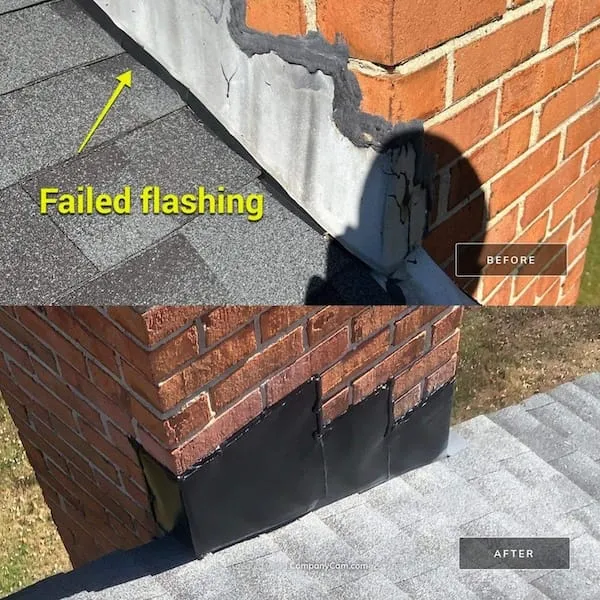
Why Choose RoofPRO for Chimney Leak Repairs in Maryland?
If you’re dealing with a chimney leak, you don’t have to face it alone. At RoofPRO, we’re here to help. As a trusted local roofing repair contractor in Maryland, we specialize in chimney leak repairs and have the expertise to get the job done right. At RoofPRO, we follow a thorough, step-by-step service process to ensure your chimney is leak-free and in top condition:
- Inspection: We start with a comprehensive inspection to identify the source of the leak. This includes checking the flashing, crown, mortar, and chimney cap.
- Diagnosis: Once we’ve identified the problem, we’ll explain it to you in detail and provide a clear plan for repairs.
- Repair: Using high-quality materials and proven techniques, we’ll fix the issue at its root. Whether it’s replacing flashing, sealing cracks, or installing a new cap, we’ve got you covered.
- Prevention: To prevent future leaks, we’ll recommend additional measures like waterproofing or regular maintenance.
Schedule Regular Roof & Chimney Inspections
One of the best ways to prevent chimneys from leaking is to schedule regular inspections. A professional roofer or chimney specialist can identify potential issues before they become major problems. Ideally, you should have your chimney inspected at least once a year, preferably before the winter season.
Chimney waterproofing is a great way to protect your chimney from water damage. This process involves applying a special sealant to the exterior of your chimney to repel water. Waterproofing can extend the life of your chimney and prevent leaks, making it a worthwhile investment for Maryland homeowners.
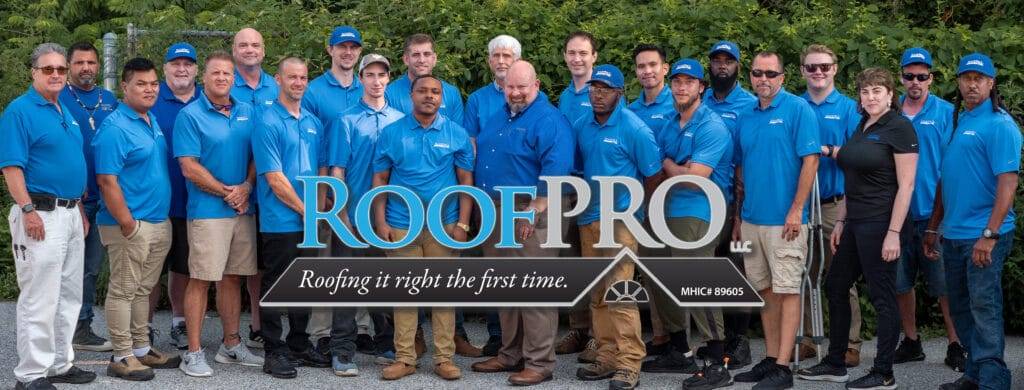
Our Complete Roofing and Siding Solutions
While chimney leaks might be the topic of the day, RoofPRO is your go-to partner for all things related to your home’s exterior. We offer a wide range of services designed to protect your investment and enhance your living space. Here’s a quick rundown:
- Roof Repair Service Solutions: From roof repairs and replacements to inspections, leak repair, and routine maintenance, our team handles every aspect of your roof. Maryland’s climate can be tough on roofs, and our expertise ensures yours stays in tip-top shape.
- Siding Solutions: Whether you need repair, replacement, installation, or storm restoration, our services have you covered. The exterior of your home is the first thing people notice, and we take pride in making sure it looks as good as it performs.
- Additional Home Improvements: Need solar panels installed? Thinking about skylights, attic ventilation, insulation, or servicing your gutters? We offer a variety of exterior remodeling service solutions designed to boost your home’s efficiency and curb appeal.
About RoofPRO
RoofPRO is a locally owned and operated home improvement company that’s been serving our community since 2004. We’re not just in the roofing and repair business; we’re in the business of keeping your home safe, comfortable, and beautiful. As a GAF-certified roofing contractor and VELUX-certified skylight installer, we meet the highest standards set by industry leaders. RoofPRO is also a proud member of the National Roofing Contractors Association (NRCA), reflecting our ongoing commitment to professionalism, safety, and excellence in every project.
We’re proud to service Anne Arundel County, Prince George’s County, Montgomery County, Howard County, and the rest of Maryland. With thousands of satisfied residential and commercial customers, RoofPRO is a name you can trust across Maryland.
Protect Your Home with RoofPRO
If you suspect a chimney leak, don’t wait. Contact the roofing experts at RoofPRO today. We’re here to help you keep your home safe, dry, and comfortable year-round.
Article Updated November 1st, 2025.

Author Bio
Tim Taylor – Owner & Founder of RoofPRO
Tim Taylor began his roofing career in 2003 and founded RoofPRO in 2004 with a mission to fix the poor workmanship that often causes roof leaks. With over 20 years of hands-on experience, he’s earned elite credentials like CertainTeed’s ShingleMaster Wizard certification, HAAG inspection certifications, and OSHA safety training. His expertise in leak repair, flashing repair, and post-storm restoration has made RoofPRO one of Maryland’s most trusted roofing companies. Tim continues to lead with the same principle that built his reputation—roof it right the first time

